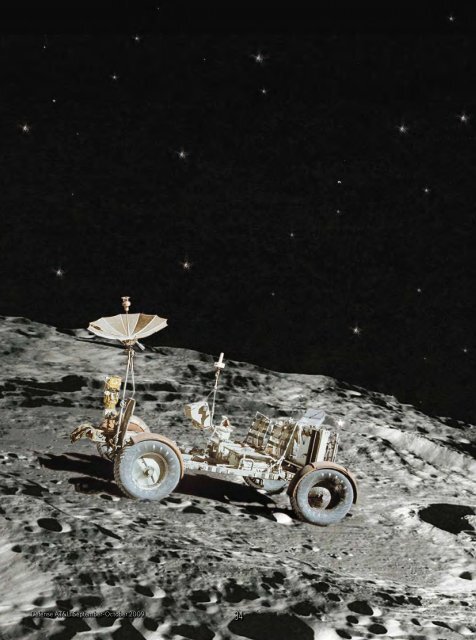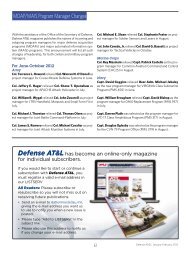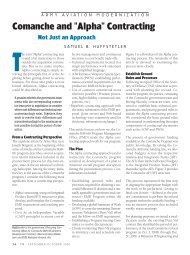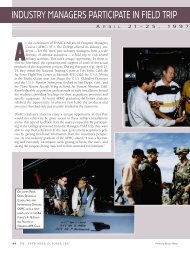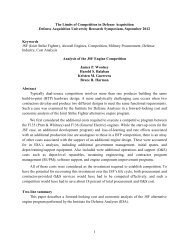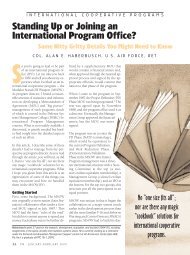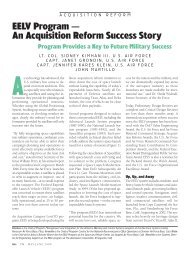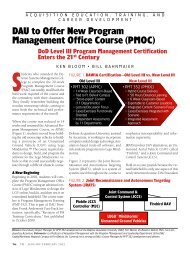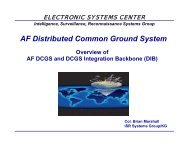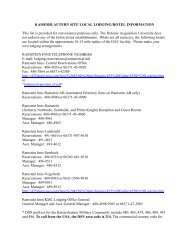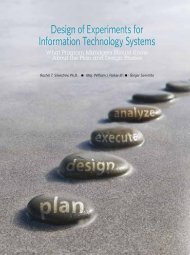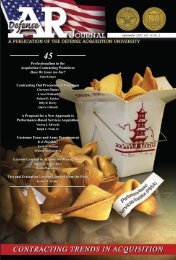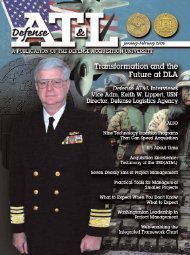Project Apollo Lights the Way for Acquisition Success
Project Apollo Lights the Way for Acquisition Success
Project Apollo Lights the Way for Acquisition Success
Create successful ePaper yourself
Turn your PDF publications into a flip-book with our unique Google optimized e-Paper software.
Defense AT&L: September-October 2009 34
<strong>Project</strong> <strong>Apollo</strong> <strong>Lights</strong> <strong>the</strong> <strong>Way</strong><br />
<strong>for</strong> <strong>Acquisition</strong> <strong>Success</strong><br />
Joe Moschler • Mike McGhee • Jerome Collins • James Weitzner<br />
It has been just over 40 years since <strong>the</strong> fulfillment of President John F. Kennedy’s goal of<br />
“landing a man on <strong>the</strong> moon and returning him safely to <strong>the</strong> earth.” As we reflect on this<br />
technological triumph, we find numerous examples of acquisition best practices and lessons<br />
learned, many of which are manifest in our current DoD acquisition management system.<br />
From its earliest stages, <strong>the</strong> U.S. space program pioneered and implemented many innovative<br />
ideas and best practices—often out of necessity—and many of those ideas have evolved and<br />
are now common tenets of today’s defense acquisition practices.<br />
<strong>Project</strong> <strong>Apollo</strong><br />
In <strong>the</strong> early days of <strong>the</strong> space race, a new program, named <strong>Project</strong> <strong>Apollo</strong>, emerged as America’s<br />
way to <strong>the</strong> moon. A developmental ef<strong>for</strong>t from <strong>the</strong> boosters up, <strong>Project</strong> <strong>Apollo</strong> initially had two<br />
major manned sub-systems—<strong>the</strong> Command and Lunar modules—and eventually gained a third<br />
sub-system called <strong>the</strong> Lunar Roving Vehicle, or Lunar Rover <strong>for</strong> short.<br />
Moschler is a Defense <strong>Acquisition</strong> University technical department chair. Collins, McGhee, and Weitzner are<br />
professors of acquisition management at <strong>the</strong> Defense <strong>Acquisition</strong> University<br />
35<br />
Defense AT&L: September-October 2009
The Command Module was designed to carry a crew of<br />
three astronauts into orbit, <strong>the</strong>n eventually return <strong>the</strong>m<br />
safely through a fiery reentry and splashdown in <strong>the</strong> ocean.<br />
Prior to being launched, it sat atop a huge three-stage rocket<br />
that stood nearly at 363 feet—58 feet taller than <strong>the</strong> 305foot<br />
Statue of Liberty—and had a diameter of 33 feet. The<br />
Lunar Module was located two stages below <strong>the</strong> Command<br />
Module on <strong>the</strong> rocket. It was a relatively fragile ship, with a<br />
cabin barely larger than <strong>the</strong> combined volume of two telephone<br />
booths. It provided adequate room <strong>for</strong> two pressuresuited<br />
astronauts, and no more. Its walls were about as thick<br />
as several layers of aluminum foil, and it was incapable of<br />
withstanding reentry into Earth’s atmosphere.<br />
Non-Developmental Items<br />
The creation of <strong>the</strong> Command and Lunar modules and <strong>the</strong><br />
Lunar Rover began with <strong>the</strong> Soviets’ successful launch of<br />
Sputnik, <strong>the</strong> world’s first manmade satellite. The National<br />
Aeronautics and Space Administration was desperate to respond<br />
to that achievement, and as a result, <strong>the</strong> organization<br />
resorted to what today we would call a non-developmental<br />
item. NASA started <strong>the</strong> Mercury and Gemini programs,<br />
which were <strong>the</strong> United States’ first tentative flights into<br />
space, using existing inter-continental ballistic missile boosters<br />
and technologies from <strong>the</strong> Redstone, Atlas, and Titan<br />
missile programs. NASA engineers made reliability and<br />
safety modifications to <strong>the</strong> missiles so human life wouldn’t<br />
be endangered by <strong>the</strong>ir use.<br />
The nation’s reputation as a world power was riding on this<br />
non-developmental but still cutting-edge technology. That<br />
same cutting-edge technology provided <strong>the</strong> foundation <strong>for</strong><br />
<strong>the</strong> United States’ early research, testing, and demonstration<br />
procedures and processes, such as ensuring a spaceship<br />
could rendezvous and dock—necessary steps in <strong>the</strong> United<br />
States’ quest to win <strong>the</strong> race to <strong>the</strong> moon.<br />
Cost and Risk<br />
Today, we routinely cite cost as an independent variable<br />
while concurrently trying to balance schedule and per<strong>for</strong>mance<br />
as dependent variables; and NASA found balancing<br />
independent and dependent variables equally as difficult<br />
as we do today. President Kennedy set a schedule of “this<br />
decade” [<strong>the</strong> 1960s] as <strong>the</strong> independent variable. NASA soon<br />
came to realize <strong>the</strong> hard way—what we, in many cases, have<br />
yet to recognize today—that <strong>the</strong>re is a fundamental law of<br />
acquisition: Program cost, schedule, and per<strong>for</strong>mance risks<br />
are inversely proportional to <strong>the</strong> respective weighted relative<br />
importance of those same variables. There<strong>for</strong>e, if an<br />
accurate program estimate exceeds <strong>the</strong> set limit <strong>for</strong> <strong>the</strong> independent<br />
variable, <strong>the</strong>n <strong>the</strong> risks <strong>for</strong> one or both of <strong>the</strong> o<strong>the</strong>r<br />
two dependent variables will be elevated beyond established<br />
acceptable limits.<br />
The prime example of that fundamental law in <strong>the</strong> <strong>Apollo</strong><br />
program was <strong>the</strong> tragic launchpad fire of <strong>Apollo</strong> 1, killing<br />
astronauts Gus Grissom, Ed White, and Roger Chaffee. Fol-<br />
Defense AT&L: September-October 2009 36<br />
lowing that tragedy, NASA coined <strong>the</strong> term “go fever” to<br />
describe what happens when schedule is permitted to reign<br />
supreme at all costs. Echoing that same sentiment, we say<br />
<strong>the</strong>se days, “If you want it bad, you get it bad.”<br />
In <strong>the</strong> <strong>Apollo</strong> program’s rush to meet schedule, acceptable<br />
per<strong>for</strong>mance risks were exceeded. Then, as now, <strong>the</strong><br />
response was <strong>the</strong> necessary redesign and rebaselining of<br />
<strong>the</strong> program. Following that loss of three lives, NASA spent<br />
two years and millions of additional dollars to get back on a<br />
course <strong>for</strong> <strong>the</strong> moon with a totally redesigned <strong>Apollo</strong> capsule.<br />
Managing <strong>the</strong> Pace of Change<br />
Ano<strong>the</strong>r initiative evident in <strong>Project</strong> <strong>Apollo</strong> that applies to<br />
today’s acquisitions is <strong>the</strong> idea of design freeze to stem<br />
requirements creep—and that happened with <strong>the</strong> Lunar<br />
Module. NASA engineers correctly recognized that effective<br />
manufacturing planning and implementation could not<br />
be achieved with a constantly changing configuration; however,<br />
some design modifications were still necessary after<br />
<strong>the</strong> design was frozen. Those changes required rigorous<br />
reviews and prudent control. The risks associated with <strong>the</strong><br />
delicate balance of making design modifications became<br />
apparent in <strong>the</strong> fifth Lunar Module manned flight, when it<br />
was discovered <strong>the</strong> onboard carbon dioxide scrubbers were<br />
not standardized with those onboard <strong>the</strong> Command Module.<br />
That almost became a fatal oversight, but was <strong>for</strong>tunately<br />
identified and overcome by creativity and ingenuity. The idea<br />
of design freeze and configuration control was clearly an<br />
early precursor to what today we call configuration steering<br />
boards.<br />
Expanding Our Capabilities<br />
One well-known but seldom-studied system from <strong>Project</strong><br />
<strong>Apollo</strong> is <strong>the</strong> Lunar Rover. Taking some literary license, we<br />
can see how <strong>the</strong> evolution of that system best illustrates <strong>the</strong><br />
logic and utility of our current defense acquisition management<br />
system.<br />
Early on in <strong>the</strong> <strong>Apollo</strong> program, Director of NASA’s Marshall<br />
Space Flight Center Dr. Werner von Braun and NASA engineers<br />
and scientists knew <strong>the</strong>y wanted to be able to explore<br />
<strong>the</strong> lunar surface beyond <strong>the</strong> immediate landing sites—<strong>the</strong>re<br />
were limitations as to how far an astronaut could explore<br />
on foot. Just as <strong>the</strong> Joint Requirements Oversight Council<br />
now validates DoD requirements, NASA implemented a<br />
process to study and evaluate <strong>the</strong> capabilities necessary<br />
to meet <strong>the</strong>ir requirements. This work was similar to what<br />
we in DoD now refer to as a capabilities-based assessment.<br />
Von Braun and his staff were convinced of <strong>the</strong> practicality of<br />
<strong>the</strong> idea and developed a plan to pursue a materiel solution;<br />
and in today’s terms, an initial capabilities document was<br />
born. With <strong>the</strong> equivalent of an approved initial capabilities<br />
document in hand, a materiel development decision was<br />
also approved and an initial materiel solution analysis was<br />
begun.
Evaluating <strong>the</strong> Options<br />
A primary activity during <strong>the</strong> materiel solution analysis<br />
phase is to conduct an analysis of alternatives, which analyzes<br />
operational effectiveness, suitability, and life cycle<br />
costs of <strong>the</strong> alternatives that satisfy <strong>the</strong> established capability<br />
needs. However, <strong>the</strong> decision to begin <strong>the</strong> materiel solution<br />
analysis phase does not mean that a new acquisition<br />
program has been initiated.<br />
Because of <strong>the</strong> lack of understanding of what kind of terrain<br />
a lunar vehicle would encounter on <strong>the</strong> moon, many types<br />
of locomotion were considered, including an Archimedean<br />
screw device, a wide range of wheel types, and track designs.<br />
After <strong>the</strong> 1962-3 unmanned lunar probes provided<br />
more detailed data about <strong>the</strong> moon’s surface, scientists and<br />
engineers were able to make some design decisions.<br />
NASA’s initial concept <strong>for</strong> <strong>the</strong> Lunar Rover vehicle was a<br />
self-contained version that could transport two or three astronauts<br />
and provide sufficient living space <strong>for</strong> up to a twoweek<br />
excursion on <strong>the</strong> moon. It soon became evident that a<br />
vehicle <strong>for</strong> such a mission would weigh approximately 8,000<br />
pounds and would require a dedicated Saturn launch rocket<br />
(meaning it couldn’t travel with <strong>the</strong> Command and Lunar<br />
modules). NASA quickly realized that <strong>the</strong> cost and complexity<br />
of that plan were not acceptable, and subsequently<br />
revised <strong>the</strong>ir plans.<br />
As previously stated, <strong>the</strong> intent of <strong>the</strong> material solution analysis<br />
phase is to determine what solutions should be pursued<br />
or developed, if any. In <strong>the</strong> case of <strong>the</strong> initial Lunar Rover<br />
program, <strong>the</strong> materiel solution analysis process worked as<br />
expected, eliminating unfeasible options. In fact, none of <strong>the</strong><br />
technologies investigated warranted fur<strong>the</strong>r pursuit because<br />
of mission constraints. In particular, <strong>the</strong> alternatives considered<br />
were not realistically achievable because <strong>the</strong> costs<br />
associated with transport to <strong>the</strong> moon were too high in terms<br />
of tradeoffs and actual dollars.<br />
One of <strong>the</strong> primary participants considered in <strong>the</strong> initial analysis<br />
was General Motors, and <strong>the</strong> company was determined<br />
that if <strong>the</strong>re was to be a car on <strong>the</strong> moon, <strong>the</strong>y were going to<br />
make it. They were willing to invest corporate funds to realize<br />
that vision, and <strong>the</strong>ir dedicated and innovative engineering<br />
team began to ask questions. What could be transported on<br />
<strong>the</strong> existing Lunar Module? What size? What weight? They<br />
learned <strong>the</strong>re was a wedge-shaped bay onboard <strong>the</strong> Lunar<br />
Module that was available to carry a small Lunar Rover.<br />
The allotted cubic space and weight restriction would be<br />
critical design factors <strong>for</strong> <strong>the</strong> vehicle. Such a vehicle would<br />
not support <strong>the</strong> two-week excursion originally envisioned by<br />
NASA, but it would allow <strong>the</strong> astronauts to venture beyond<br />
<strong>the</strong>ir limited walking range. After two General Motors engineers<br />
demonstrated an ingenious prototype to von Braun,<br />
NASA decided to proceed once more with developments <strong>for</strong><br />
a Lunar Rover. In a classic example of capability tradeoffs,<br />
37<br />
Today, we routinely cite cost as<br />
an independent variable while<br />
concurrently trying to balance<br />
schedule and per<strong>for</strong>mance as<br />
dependent variables; and NASA<br />
found balancing independent<br />
and dependent variables<br />
equally as difficult<br />
as we do today.<br />
NASA reduced <strong>the</strong> requirements <strong>for</strong> <strong>the</strong> Lunar Rover from<br />
a vehicle that could transport two or three astronauts <strong>for</strong> a<br />
two-week journey to one that could simply extend <strong>the</strong> astronauts’<br />
range on <strong>the</strong> moon and could be transported on<br />
<strong>the</strong> Lunar Module.<br />
Maturing and Prototyping <strong>the</strong> Technology<br />
With <strong>the</strong> benefit of hindsight, we would now say that NASA<br />
was entering what <strong>the</strong> defense acquisition community calls<br />
<strong>the</strong> technology development phase. The Lunar Rover had<br />
already made a long journey up to this point—but <strong>the</strong> journey<br />
was only just beginning. Although General Motors had<br />
developed an innovative and promising design, that did not<br />
guarantee <strong>the</strong>m <strong>the</strong> contract award. NASA conducted full<br />
and open competition <strong>for</strong> <strong>the</strong> Lunar Rover contract.<br />
Grumman Aircraft Engineering Corporation, <strong>the</strong> builder of<br />
<strong>the</strong> Lunar Module, entered a prototype that was a strong<br />
contender. It was a close competition, and Grumman very<br />
nearly won <strong>the</strong> bid with a design featuring conical wheels<br />
that could be removed and stowed toge<strong>the</strong>r to save space.<br />
Grumman’s design also had <strong>the</strong> capability to be remotely operated<br />
from Mission Control, even after <strong>the</strong> astronauts had<br />
returned safely home. But in <strong>the</strong> end, <strong>the</strong> ease of deployability<br />
was <strong>the</strong> deciding factor, and General Motors (partnered<br />
as a major subcontractor under Boeing), won <strong>the</strong> bid. Like<br />
a detachable Murphy bed with wheels, <strong>the</strong> General Motors<br />
design featured spring-loaded hinges that allowed <strong>for</strong> minimal<br />
exertion of <strong>the</strong> astronauts’ energy and time—it literally<br />
sprang out of <strong>the</strong> cargo hold. Although <strong>the</strong> Grumman design<br />
featured somewhat more robust per<strong>for</strong>mance characteris-<br />
Defense AT&L: September-October 2009
tics, it also required a substantial amount of time and energy<br />
to assemble—resources that were just not available based<br />
on <strong>the</strong> limited supply of consumables.<br />
Once <strong>the</strong> competitive prototypes were evaluated, a contract<br />
was awarded to <strong>the</strong> General Motors Defense Research<br />
Labs—although Boeing was <strong>the</strong> prime contractor, <strong>the</strong> design<br />
was General Motor’s baby. What we today call <strong>the</strong> engineering<br />
manufacturing and development phase began. The<br />
hard part was yet to come—actually building a vehicle that<br />
would fit onboard <strong>the</strong> Lunar Module and operate on <strong>the</strong> lunar<br />
surface once it arrived. Engineers faced <strong>the</strong> task of reducing<br />
technology risk through <strong>the</strong> maturing of critical technology<br />
elements. Additionally, <strong>the</strong> team had a very aggressive<br />
schedule of delivering <strong>the</strong> Lunar Rover—it had to be delivered<br />
in just 17 months if it was to be incorporated into <strong>Apollo</strong> 15.<br />
From <strong>the</strong> onset of <strong>the</strong> program, deployability and weight<br />
were <strong>the</strong> two attributes of <strong>the</strong> Lunar Rover considered critical<br />
to <strong>the</strong> operation of <strong>the</strong> system. Today, we would call <strong>the</strong>m<br />
<strong>the</strong> key per<strong>for</strong>mance parameters <strong>for</strong> <strong>the</strong> system. If <strong>the</strong> Lunar<br />
Rover could not be stored in <strong>the</strong> 5x5x5-foot wedge-shaped<br />
space in <strong>the</strong> Lunar Module, <strong>the</strong>n it would not get to <strong>the</strong><br />
moon. Fur<strong>the</strong>rmore, if <strong>the</strong> astronauts were not able to easily<br />
deploy <strong>the</strong> Rover once <strong>the</strong>y arrived on <strong>the</strong> moon’s surface,<br />
it would be of little value.<br />
Because <strong>the</strong> Lunar Module hovered over <strong>the</strong> moon’s surface<br />
looking <strong>for</strong> a spot to land, weight of <strong>the</strong> vehicle was critical.<br />
Every ounce of additional weight carried meant a decrease in<br />
<strong>the</strong> available hover time <strong>for</strong> <strong>the</strong> Lunar Module pilot to find a<br />
suitable spot to land. There<strong>for</strong>e, <strong>the</strong> Lunar Rover’s maximum<br />
weight, or threshold, was set at 400 pounds. Of course,<br />
<strong>the</strong>re were o<strong>the</strong>r key system attributes that had to be considered,<br />
such as reliability.<br />
Some of <strong>the</strong> technology development ef<strong>for</strong>ts General Motors<br />
undertook included developing a battery that both<br />
weighed less than 10 pounds and could dissipate heat during<br />
operation, capitalizing on <strong>the</strong> properties of wax to ab-<br />
From <strong>the</strong> onset of <strong>the</strong> program,<br />
deployability and weight were<br />
<strong>the</strong> two attributes of <strong>the</strong> Lunar<br />
Rover considered critical to <strong>the</strong><br />
operation of <strong>the</strong> system.<br />
Defense AT&L: September-October 2009 38<br />
sorb <strong>the</strong> heat while in operation and <strong>the</strong>n cool and dissipate<br />
that same heat when <strong>the</strong> Rover was not running. Ano<strong>the</strong>r<br />
technology issue was that <strong>the</strong> dust on <strong>the</strong> moon adhered to<br />
everything it touched, so <strong>the</strong> engineers and scientists had<br />
to develop a wheel capable of shedding dust so it wouldn’t<br />
build up on and around <strong>the</strong> hub and brakes. Their successful<br />
approach to that challenge resulted in a wheel constructed<br />
of woven piano wire.<br />
The Rover in Action<br />
The engineering manufacturing and development phase<br />
ended on schedule after 17 months, with delivery of <strong>the</strong> first<br />
Lunar Rover to NASA on March 10, 1971. The Lunar Rover<br />
was first used on July 31, 1971, during <strong>the</strong> <strong>Apollo</strong> 15 mission.<br />
The mission wasn’t without problems, however. Once deployed<br />
on <strong>the</strong> moon, <strong>the</strong> <strong>Apollo</strong> 15 crew experienced problems<br />
with <strong>the</strong> front-wheel steering. Fortunately, <strong>the</strong> Lunar<br />
Rover also had rear steering, so <strong>the</strong> mission could continue.<br />
Thus, as that experience proves, even if significant developmental<br />
testing and operational assessments are done on a<br />
system, problems still can occur during operational testing<br />
on a deployed vehicle.<br />
During <strong>the</strong> <strong>Apollo</strong> 15, 16, and 17 missions, <strong>the</strong> Lunar Rover<br />
traversed approximately 56 miles, allowing <strong>the</strong> astronauts<br />
to explore <strong>the</strong> moon’s surface to an extent never be<strong>for</strong>e<br />
achieved.<br />
Learning From <strong>the</strong> Past<br />
The significance of <strong>the</strong> achievements and innovations of <strong>the</strong><br />
<strong>Apollo</strong> program, and more specifically, <strong>the</strong> Lunar Rover program,<br />
is not lost over time. Even though <strong>the</strong> NASA engineers<br />
at that time didn’t have <strong>the</strong> structured DoD acquisition management<br />
system to guide <strong>the</strong>m as we do now, <strong>the</strong>y still used<br />
a very systematic approach to acquiring <strong>the</strong> Lunar Rover<br />
and o<strong>the</strong>r <strong>Apollo</strong> systems. That systematic approach, when<br />
applied deliberately, led to great programmatic success <strong>for</strong><br />
<strong>Project</strong> <strong>Apollo</strong>, as <strong>the</strong> Lunar Rover success demonstrates.<br />
However, as expressed in a recent interview with current<br />
U.S. astronaut Heidemarie Stefanyshyn-Piper (captain, U.S.<br />
Navy), who flew on space missions STS-115 and STS-126,<br />
“The biggest change has been our acquisition strategy. We<br />
are no longer in a space race, and cost is a far greater concern.”<br />
The same disciplined approaches of <strong>the</strong> <strong>Apollo</strong> team members<br />
are as valid today, if not more so, than <strong>the</strong>y were 40<br />
years ago. The lessons and principles still apply in <strong>the</strong> strategic<br />
and tactical execution of programs, whe<strong>the</strong>r in support<br />
of a mission to <strong>the</strong> moon or providing <strong>for</strong> <strong>the</strong> daily support<br />
and protection of our troops.<br />
The authors welcome comments and questions and can be<br />
contacted at joe.moschler@dau.mil, mike.mcghee@dau.mil,<br />
jerome.collins@dau.mil, and james.weitzner@dau.mil.


